Pranayama, the ancient yogic practice of controlling the breath, holds significant importance in the realm of holistic well-being. Among its various techniques, Kapalabhati Pranayama stands out for its invigorating effects on both the body and mind. Originating from the Sanskrit words ‘kapala’ (skull) and ‘bhati’ (shining), Kapalabhati Pranayama is often referred to as the Skull Shining Breath due to its ability to cleanse and rejuvenate the mind and body. In this comprehensive guide, we delve into the origins, benefits, step-by-step instructions, variations, scientific research, precautions, and contraindications associated with this powerful breathing exercise.
Origins and Significance
Kapalabhati Pranayama finds its roots in ancient yogic texts, particularly the Hatha Yoga Pradipika and the Gheranda Samhita, dating back to thousands of years. It is believed to have been developed by yogis as a means to purify the body and prepare it for deeper meditative practices. The name ‘Kapalabhati’ derives from its transformative effects, as it is said to cleanse the cranial region and awaken higher consciousness.
In yogic philosophy, the skull is considered the seat of the mind, and by practicing Kapalabhati, practitioners aim to purify this region, eliminating mental impurities and enhancing mental clarity. Additionally, Kapalabhati is often incorporated into Kriya Yoga, a practice focused on cleansing the body and mind to facilitate spiritual growth.
Benefits
The benefits of Kapalabhati Pranayama extend beyond the physical realm to encompass mental, emotional, and spiritual well-being. Some of the key benefits include:
1. Improved Respiratory Function: Kapalabhati Pranayama strengthens the respiratory muscles and increases lung capacity, leading to improved oxygenation of the blood and enhanced vitality.
2. Detoxification: By rapidly expelling stale air from the lungs and stimulating the detoxification process, Kapalabhati helps rid the body of toxins and impurities, promoting overall health and well-being.
3. Enhanced Mental Clarity: The rhythmic nature of Kapalabhati Pranayama calms the mind, clears mental fog, and enhances focus and concentration, making it an excellent practice for increasing productivity and mental clarity.
4. Stress Reduction: Kapalabhati activates the parasympathetic nervous system, inducing a state of relaxation and reducing stress and anxiety levels. Regular practice can help manage chronic stress and promote emotional balance.
5. Boosted Energy Levels: The invigorating effects of Kapalabhati Pranayama stimulate the nervous system and increase energy levels, making it an excellent practice for combating fatigue and lethargy.
6. Improved Digestion: The rhythmic contraction and expansion of the abdominal muscles during Kapalabhati massage the internal organs, promoting better digestion and alleviating digestive issues such as bloating and constipation.
Step-by-Step Instructions
Practicing Kapalabhati Pranayama requires proper technique and mindful breathing. Follow these step-by-step instructions to perform the Skull Shining Breath:
1. Preparation: Find a comfortable seated position on the floor or a chair, ensuring that your spine is erect and your shoulders are relaxed. Place your hands on your knees or thighs in a relaxed position.
2. Inhalation: Take a deep inhalation through both nostrils, expanding your abdomen as you fill your lungs with air.
3. Exhalation: Quickly and forcefully exhale through both nostrils by contracting your abdominal muscles. The exhalation should be short and snappy, with the emphasis on the outward movement of the abdomen.
4. Rhythm: Maintain a steady rhythm, with each exhalation followed immediately by a passive inhalation. The exhalation should be twice as fast as the inhalation, creating a rhythmic pumping action.
5. Repetition: Continue this pumping action for 20-30 breaths, gradually increasing the duration as you build stamina and proficiency. Focus on the forceful exhalation while keeping the inhalation passive and natural.
6. Relaxation: After completing the desired number of breaths, release the abdominal contraction and allow your breath to return to its natural rhythm. Take a few deep breaths to center yourself and observe any sensations in the body and mind.
7. Duration: Beginners may start with 1-2 rounds of Kapalabhati Pranayama, gradually increasing to 3-5 rounds as they become more comfortable with the practice.
Variations
While the basic technique of Kapalabhati remains the same, there are variations that can be incorporated to customize the practice according to individual needs and preferences:
1. Slow Kapalabhati: Instead of rapid exhalations, slow down the pace and focus on smooth, controlled breaths. This variation is suitable for beginners or those with respiratory issues.
2. Kriya Kapalabhati: Combine Kapalabhati with breath retention (kumbhaka) by holding the breath after each exhalation. This advanced variation intensifies the cleansing and energizing effects of the practice.
3. Standing Kapalabhati: Practice Kapalabhati while standing upright, with the arms raised overhead or placed on the hips. This variation enhances circulation and can be energizing when performed in the morning.
4. Seated Twist Kapalabhati: Incorporate a spinal twist while performing Kapalabhati by twisting the torso to the right on inhalation and to the left on exhalation. This variation improves spinal flexibility and aids in detoxification.
Scientific Research and Evidence
While the ancient yogic texts extol the benefits of Kapalabhati Pranayama, modern scientific research has also shed light on its efficacy in promoting physical and mental well-being. Several studies have investigated the physiological and psychological effects of Kapalabhati, yielding promising results:
1. Respiratory Benefits: A study published in the International Journal of Yoga found that regular practice of Kapalabhati Pranayama improved lung function and respiratory muscle strength in healthy adults, indicating its potential as a therapeutic intervention for respiratory disorders.
2. Stress Reduction: Research published in the Journal of Alternative and Complementary Medicine demonstrated that Kapalabhati Pranayama significantly reduced stress and anxiety levels in individuals with mild hypertension, suggesting its role in stress management and relaxation.
3. Cognitive Function: A study published in the Journal of Physical Therapy Science reported that Kapalabhati Pranayama enhanced cognitive function and attention span in young adults, highlighting its cognitive benefits beyond physical health.
4. Cardiovascular Health: Preliminary research suggests that Kapalabhati Pranayama may have beneficial effects on cardiovascular health by reducing blood pressure and improving endothelial function, though further studies are warranted to elucidate its mechanisms of action.
While the existing research provides valuable insights into the potential benefits of Kapalabhati Pranayama, more rigorous studies are needed to establish its efficacy and safety across diverse populations and clinical conditions.
Conclusion
By incorporating Kapalabhati Pranayama into a regular yoga or meditation practice, individuals can harness its transformative power to cultivate balance, resilience, and inner harmony. As we delve deeper into the ancient wisdom of yoga, practices like Kapalabhati Pranayama serve as timeless reminders of the profound connection between breath, body, and consciousness, guiding us on a journey towards optimal health and self-realization.



















